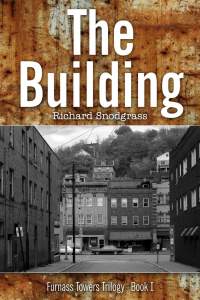
The first book in Richard Snodgrass’ Furnass Towers Trilogy, The Building is an evocative work of literary fiction, in which the construction of an apartment tower acts as a pivot to unveil an eccentric cast of characters, allowing Snodgrass to deftly weave the stories of the people in this struggling mill town.
Usually, with a cast this big, it is possible to lose focus and drain tension. However, The Building works in the opposite direction: every point of view reveals a little bit more and every switch has the satisfaction of putting the right puzzle piece into place – slowly making the picture whole. In between the story, there are long sections of italicized narrative that works to set the tone and adds a base to the canvas, which colors each character.
Snodgrass has also managed to make every point of view distinct, moving effortlessly between styles. Pamela especially sticks out as a favorite. Snodgrass does not fall victim to stereotypical portrayals of women – she has depth and carries herself through her narrative in such a way that makes the reader sad to say goodbye. “The Building” is the final character, which gives a framework for this curious group of characters’ conflicts with themselves, and with each other.
While the novel is successful as a character-driven work, there are some problems that affect the prose as a whole. Snodgrass occasionally linger too long on details that, in hindsight, seem inconsequential. There is also a fair bit of extraneous detail about each character, which does help to introduce them quickly and vividly, but at times reads like micro-managing. It would have benefited the novel to have more passages of introspection with the characters, where Snodgrass could have tackled some of the grander ideas that simmer under the surface.
Subtlety is of course vital to effective fiction, but here the issue is that the narrative is at times overly detailed and other times not detailed enough, giving the story an uneven quality. As a result, the problems that the building encounters, especially towards the final third of the book, do not seem to pack the satisfying punch that the author might expect — although the love story that underlines it adds a fair degree of interest and depth.
The prose itself is crisp and quite lean, which allows for an easy and page-turning read overall. The shining light throughout is the dialogue. Snappy and believable, it gives a real sense of place to the novel, and reveals the innate differences – and similarities – between these characters, who come from different walks of life. In the final part, there is clever use of unquoted speech that flows effortlessly with the scene, showing off Snodgrass’s chops as a prose stylist.
In all, The Building is a fine novel and sets up the rest of the trilogy well. This eclectic and well-drawn cast of characters will inspire readers to binge through the rest of the trilogy, as each character is innately recognizable, representing fears, insecurities, and hopes that drive all of us. Though on the surface it’s a novel about a single building in a small town, the novel has a big story to tell within an inventive literary framework, making The Building an ambitious and intricately woven work of literary fiction.
Book Links
STAR RATING
Design
Content
Editing
Get an Editorial Review | Get Amazon Sales & Reviews | Get Edited | Get Beta Readers | Enter the SPR Book Awards | Other Marketing Services























Leave A Comment